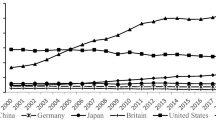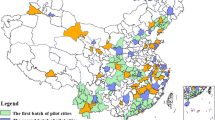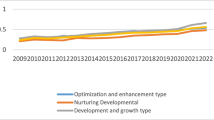Abstract
The development of a city’s green infrastructure is increasingly being driven by low-carbon innovation (LCI). However, knowledge of how LCI affects green economic efficiency (GEE) in China is largely unknown. This study investigates the spatial effects of LCI on GEE in 285 Chinese prefecture-level cities. The empirical findings show that LCI exerts significant beneficial effects on its GEE but negative effects on its neighbors. The positive direct effects on GEE are offset by negative indirect effects due to the lack of spatial linkage effect and the existence of the siphon and crowding-out effects among cities. Using a mediating effect model, we have identified three channels of LCI that affect GEE: industrial structure, energy consumption structure, and human capital. A further heterogeneity analysis indicates that the impacts of LCI on GEE differ by region and city development level. Furthermore, LCI in the building, greenhouse gas treatment, transportation, and sewage and pollutant treatment categories could greatly enhance local GEE. The findings herein provide an empirical experience for accurately accessing the spatial effect of LCI on GEE, and offer a critical decision-making reference for implementing a cross-city green linkage development mechanism.





Similar content being viewed by others
Data availability
The datasets generated or analyzed during this study are available from the first author on reasonable request.
References
Albino, V., Ardito, L., Dangelico, R. M., & Petruzzelli, A. M. (2014). Understanding the development trends of low-carbon energy technologies: A patent analysis. Applied Energy, 135, 836–854.
Anselin, L. (2010). Thirty years of spatial econometrics. Papers in Regional Science, 89, 3–25.
Arrow, K. J. (1971). The Economic Implications of Learning by Doing. In Readings in the Theory of Growth. London: Palgrave Macmillan
Balaguer, J., & Cantavella, M. (2018). The role of education in the environmental Kuznets curve. Evidence from Australian Data. Energy Economics, 70, 289–296.
Bi, K., Huang, P., & Wang, X. (2016). Innovation performance and influencing factors of low-carbon innovation under the global value chain: A case of Chinese manufacturing industry. Technological Forecasting and Social Change, 111, 275–284.
Brabazon, T. (2014). Unique urbanity?: Rethinking third tier cities, degeneration, regeneration and mobility. Springer.
Cho, J. H., & Sohn, S. Y. (2018). A novel decomposition analysis of green patent applications for the evaluation of R&D efforts to reduce CO2 emissions from fossil fuel energy consumption. Journal of Cleaner Production, 193, 290–299.
Cui, J., Zhang, J., & Zheng, Y. (2018). Carbon pricing induces innovation: Evidence from China’s regional carbon market pilots. AEA Papers and Proceedings, 108, 453–457.
Cullinane, K., Wang, T. F., Song, D. W., & Ji, P. (2006). The technical efficiency of container ports: Comparing data envelopment analysis and stochastic frontier analysis. Transportation Research Part a: Policy and Practice, 40(4), 354–374.
Dietz, T., Shwom, R. L., & Whitley, C. T. (2020). Climate change and society. Annual Review of Sociology, 46, 135–158.
Du, K., & Li, J. (2019). Towards a green world: How do green technology innovations affect total factor carbon productivity. Energy Policy, 131, 240–250.
Elhorst, J. P. (2014). Spatial econometrics from cross-Sectional data to spatial panels. Springer.
Hao, L. N., Umar, M., Khan, Z., & Ali, W. (2021). Green growth and low carbon emission in G7 countries: How critical the network of environmental taxes, renewable energy and human capital is? Science of the Total Environment, 752, 141853.
Helveston, J., & Nahm, J. (2019). China’s key role in scaling low-carbon energy technologies. Science, 366(6467), 794–796.
Jin, S., Wang, W., Qalati, S. A., Zhang, C., Lu, N., Zhu, G., & Wu, J. (2022). Can low-carbon technological innovation reduce haze pollution?: Based on spatial econometric analysis. Frontiers in Environmental Science, 10, 893194.
Jordaan, S. M., Romo-Rabago, E., McLeary, R., Reidy, L., Nazari, J., & Herremans, I. M. (2017). The role of energy technology innovation in reducing greenhouse gas emissions: A case study of Canada. Renewable and Sustainable Energy Reviews, 78, 1397–1409.
Krugman, P. (1991). Increasing returns and economic geography. Journal of Political Economics, 99(3), 483–499.
Kumar, R. R., Stauvermann, P. J., & Patel, A. (2016). Exploring the link between research and economic growth: An empirical study of China and USA. Quality and Quantity, 50(3), 1073–1091.
Lee, C. C., & Lee, C. C. (2022). How does green finance affect green total factor productivity? Evidence from China. Energy Economics, 107, 105863.
LeSage, J., & Pace, R. K. (2009). Introduction to Spatial Econometrics. CRC Press.
Li, W., Xu, J., Ostic, D., Yang, J., Guan, R., & Zhu, L. (2021). Why low-carbon technological innovation hardly promote energy efficiency of China?: Based on spatial econometric method and machine learning. Computers and Industrial Engineering, 160, 107566.
Li, Z., Zhang, R., & Zhu, H. (2022). Environmental regulations, social networks and corporate green innovation: How do social networks influence the implementation of environmental pilot policies? Environment, Development and Sustainability. https://doi.org/10.1007/s10668-022-02778-6
Liu, X., & Zhang, X. (2021). Industrial agglomeration, technological innovation and carbon productivity: Evidence from China. Resources, Conservation and Recycling, 166, 105330.
Liu, Y., & Dong, F. (2021). How technological innovation impacts urban green economy efficiency in emerging economies: A case study of 278 Chinese cities. Resources, Conservation and Recycling, 169, 105534.
Loiseau, E., Saikku, L., Antikainen, R., Droste, N., Hansjürgens, B., Pitkänen, K., Leskinen, P., Kuikman, P., & Thomsen, M. (2016). Green economy and related concepts: An overview. Journal of Cleaner Production, 139, 361–371.
Luo, Y., Lu, Z., Salman, M., & Song, S. (2022). Impacts of heterogenous technological innovations on green productivity: An empirical study from 261 cities in China. Journal of Cleaner Production, 334, 130241.
Meng, L., Graus, W., Worrell, E., & Huang, B. (2014). Estimating CO2 (carbon dioxide) emissions at urban scales by DMSP/OLS (Defense Meteorological Satellite Program’s Operational Linescan System) nighttime light imagery: Methodological challenges and a case study for China. Energy, 71, 68–478.
Menyah, K., Nazlioglu, S., & Wolde-Rufael, Y. (2014). Financial development, trade openness and economic growth in African countries: New insights from a panel causality approach. Economic Modelling, 37, 386–394.
Nunn, N., & Qian, N. (2014). US food aid and civil conflict. American Economic Review, 104(6), 1630–1666.
Peng, W., Yin, Y., Kuang, C., Wen, Z., & Kuang, J. (2021). Spatial spillover effect of green innovation on economic development quality in China: Evidence from a panel data of 270 prefecture-level and above cities. Sustainable Cities and Society, 69, 102863.
Popp, D. (2012). The role of technological change in green growth. National Bureau of Economic Research. http://www.nber.org/papers/w18506
Sha, R., Li, J., & Ge, T. (2021). How do price distortions of fossil energy sources affect China’s green economic efficiency? Energy, 232, 121017.
Shao, S., Fan, M., & Yang, L. (2022). Economic restructuring, green technical progress, and low-carbon transition development in China: An empirical investigation based on the overall technology frontier and spatial spillover effect. Management World, 38(2), 46–69.
Shao, S., Luan, R., Yang, Z., & Li, C. (2016). Does directed technological change get greener: Empirical evidence from Shanghai’s industrial green development transformation. Ecological Indicators, 69, 758–770.
Shi, Q., & Lai, X. (2013). Identifying the underpin of green and low carbon technology innovation research: A literature review from 1994 to 2010. Technological Forecasting and Social Change, 80(5), 839–864.
Solow, R. M. (1956). A contribution to the theory of economic growth. Quarterly Journal of Economics, 70, 65–94.
Song, Z., Storesletten, K., & Zilibotti, F. (2011). Growing like China. American Economic Review, 101(1), 196–233.
Tobler, W. R. (1970). A computer movie simulating urban growth in the Detroit region. Economic Geography, 46(sup1), 234–240.
Tone, K. (2003). Dealing with undesirable outputs in DEA: A slacks-based measure (SBM) approach. GRIPS Research Report Series, I-2003–0005.
Tone, K. (2002). A slacks-based measure of super-efficiency in data envelopment analysis. European Journal of Operational Research, 143(1), 32–41.
Torres-Preciado, V. H., Polanco-Gaytán, M., & Tinoco-Zermeño, M. Á. (2014). Technological innovation and regional economic growth in Mexico: A spatial perspective. Annals of Regional Science, 52(1), 183–200.
Walker, N. L., Williams, A. P., & Styles, D. (2020). Key performance indicators to explain energy & economic efficiency across water utilities, and identifying suitable proxies. Journal of Environmental Management, 269, 110810.
Wang, G., & Salman, M. (2022). The impacts of heterogeneous environmental regulations on green economic efficiency from the perspective of urbanization: A dynamic threshold analysis. Environment, Development and Sustainability. https://doi.org/10.1007/s10668-022-02443-y
Wang, W., Lu, N., & Zhang, C. (2018). Low-carbon technology innovation responding to climate change from the perspective of spatial spillover effects. Chinese Journal of Population Resources and Environment, 16(2), 120–130.
Wang, H., Cui, H., & Zhao, Q. (2021a). Effect of green technology innovation on green total factor productivity in China: Evidence from spatial durbin model analysis. Journal of Cleaner Production, 288, 125624.
Wang, K. H., Umar, M., Akram, R., & Caglar, E. (2021b). Is technological innovation making world “Greener”? An evidence from changing growth story of China. Technological Forecasting and Social Change, 165, 120516.
Wong, C. Y., Mohamad, Z. F., Keng, Z. X., & Azizan, S. A. (2014). Examining the patterns of innovation in low carbon energy science and technology: Publications and patents of Asian emerging economies. Energy Policy, 73, 789–802.
Xu, L., Fan, M., Yang, L., & Shao, S. (2021). Heterogeneous green innovations and carbon emission performance: Evidence at China’s city level. Energy Economics, 99, 105269.
Yan, Z., Yang, Z., & Du, K. (2017). Impact of low-carbon technological innovation on carbon intensity. Finance & Trade Economics, 38(8), 112–128.
Yang, C., & Liu, S. (2020). Spatial correlation analysis of low-carbon innovation: A case study of manufacturing patents in China. Journal of Cleaner Production, 273, 122893.
Yang, X., Lin, S., Li, Y., & He, M. (2019). Can high-speed rail reduce environmental pollution? Evidence from China. Journal of Cleaner Production, 239, 118135.
Yuan, H., Feng, Y., Lee, C. C., & Cen, Y. (2020). How does manufacturing agglomeration affect green economic efficiency? Energy Economics, 92, 104944.
Zhang, C., Zhou, Y., & Li, Z. (2022c). Low-carbon innovation, economic growth, and CO2 emissions: Evidence from a dynamic spatial panel approach in China. Environmental Science and Pollution Research. https://doi.org/10.1007/s11356-022-23890-0
Zhang, Z., Zhang, G., & Li, L. (2022a). The spatial impact of atmospheric environmental policy on public health based on the mediation effect of air pollution in China. Environmental Science and Pollution Research. https://doi.org/10.1007/s11356-022-21501-6
Zhang, Z., Zhang, G., & Su, B. (2022b). The spatial impacts of air pollution and socio-economic status on public health: Empirical evidence from China. Socio-Economic Planning Sciences, 83, 101167.
Zhao, P. J., Zeng, L. E., Lu, H. Y., Zhou, Y., Hu, H. Y., & Wei, X. Y. (2020). Green economic efficiency and its influencing factors in China from 2008 to 2017: Based on the super-SBM model with undesirable outputs and spatial Dubin model. Science of Total Environment, 741, 140026.
Zhou, P., Delmas, M. A., & Kohli, A. (2017). Constructing meaningful environmental indices: A nonparametric frontier approach. Journal of Environmental Economics and Management, 85, 21–34.
Zhu, B. Z., Zhang, M. F., Zhou, Y. H., Wang, P., Sheng, J. C., He, K. J., Wei, Y. M., & Xie, R. (2019). Exploring the effect of industrial structure adjustment on interprovincial green development efficiency in China: A novel integrated approach. Energy Policy, 134, 110946.
Acknowledgements
This work is supported by the National Planning Office of Philosophy and Social Science Foundation of China (22BJL030) and Cultivation Project of the Major Research for Medium and Long-term Research in Philosophy and Social Sciences of Northeast Normal University (22FR006).
Author information
Authors and Affiliations
Contributions
HR contributed to writing—original draft, methodology, software. GG contributed to conceptualization, funding acquisition, and supervision. HZ contributed to methodology, writing–review and editing, validation, and supervision.
Corresponding author
Ethics declarations
Conflict of interest
The authors declare that they have no known competing financial interests or personal relationships that could have appeared to influence the work reported in this paper.
Additional information
Publisher's Note
Springer Nature remains neutral with regard to jurisdictional claims in published maps and institutional affiliations.
Rights and permissions
Springer Nature or its licensor (e.g. a society or other partner) holds exclusive rights to this article under a publishing agreement with the author(s) or other rightsholder(s); author self-archiving of the accepted manuscript version of this article is solely governed by the terms of such publishing agreement and applicable law.
About this article
Cite this article
Ren, H., Gu, G. & Zhou, H. How low-carbon innovation drives city’s green development? Evidence from China. Environ Dev Sustain 26, 9335–9367 (2024). https://doi.org/10.1007/s10668-023-03098-z
Received:
Accepted:
Published:
Issue Date:
DOI: https://doi.org/10.1007/s10668-023-03098-z






